History of Russian animation
The History of Russian animation is the film art produced by Russian animation makers. As most of Russia's production of animation for film|cinema and television were created during Soviet times, it may also be referred to some extent as the History of Soviet animation. It remains a nearly unexplored field in film theory and history outside Russia.
Beginnings
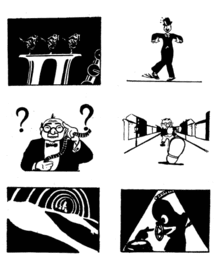
The first animator in Russia was Aleksander Shiryayev, who was a principal dancer at the Imperial Russian Ballet, as well as a teacher and choreographer. He made a number of pioneering puppet-animated ballet films between 1906 and 1909. He only showed them to a few people, and they were forgotten until their re-discovery in 1995.[1][2]
The second person in Russia to independently discover animation was Ladislas Starevich, who was of Polish descent and is therefore also known by the name of Wladyslaw Starewicz. Being a trained biologist, he started to make animation with embalmed insects for educational purposes, but soon realized the possibilities of his medium to become one of the undisputed masters of stop motion later in his life. His first few films, made in 1910, were dark comedies on the family lives of cockroaches, and were so revolutionary that they earned Starevich a decoration from the Tsar.
Socialist realism
In 1934, Walt Disney sent a film reel with some shorts of Mickey Mouse to the Moscow Film Festival.

In 1935, the Soyuzdetmultfilm-Studio was created from the small and relatively independent trickfilm units of Mosfilm, Sovkino and Mezhrabpromfilm in order to focus on the creation of Disney-style animation, exclusively using cel technique.
From Khrushchev Thaw to Perestroika
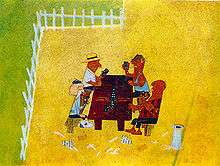
When Nikita Khrushchev in 1956 proclaimed the end of the personality cult of Joseph Stalin, he started a process of political and cultural renewal in the country. Even though animators still needed a while to free themselves from the long tradition of "Éclair", from the 1960s onwards, animation films gain completely new qualities. The starting point for this was Fyodor Khitruk's film The Story of a Crime (1962). Not only had he changed the animation style to something that resembled what the United Productions of America was doing, but for the first time since the avantgarde years, he was able to tackle a contemporary story.
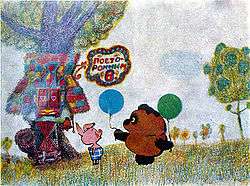
Khitruk's revolutionary approach paved the way for a vast number of young animation directors that in the following years developed their own distinctive styles and approaches. One of the most political was Andrei Khrzhanovsky, whose surrealist film The Glass Harmonica (1968) was severely cut by censors, but shelved nevertheless. Anatoly Petrov is known as the founder of the cinema journal Vesyolaya Karusel (The Happy Merry-Go-Round, since 1969) that gave an opportunity to many young directors to make their first own films. Among them were Leonid Nosyrev, Valery Ugarov, Eduard Nazarov, Ivan Ufimcev and others.
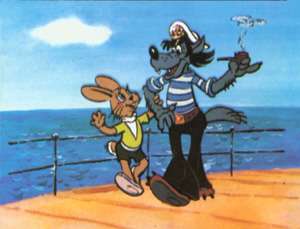
The 1970s saw the birth of the Soviet Union's most popular animation series, Nu, Pogodi! (Just you wait!), directed by Vyacheslav Kotyonochkin. These seemingly simple miniatures about a wolf chasing a hare through Soviet-style cartoon worlds owe a great deal of their popularity to the cunning subtexts built into their parts.
During the Stalin period, puppet animation had come to a halt. Only in 1953 was a puppet division was refounded at Soyuzmultfilm. Its first head of department was Boris Degtyarev, under whose direction young animators tried to recover the knowledge that had been lost since the time of Aleksandr Ptushko. Among the most outstanding of these young artists were Vadim Kurchevskiy and Nikolay Serebryakov, who worked together for their first films, e.g. The Cloud in Love (1963). Even when they decided to separate and make their own films, their style was marked by an extensive aesthetic search for, as Bendazzi puts it, "the combination of realism and the baroque", most clearly to be seen in Not in the Hat is there Happiness (1968, by Serebrjakov) and especially in Kurchevskiy's masterpiece, The Master of Clamecy (1972, after Romain Rolland's novel Colas Breugnon). One generation later, Stanislav Sokolov started to make movies that brought the art of puppet animation to a new height. His approach, characterized by complex animation structures and multiple special effects can well be observed in The Big Underground Ball (1987, after Andersen) or Black and White Film (1985), which won a prize in Zagreb.
Adventures of Mowgli made by Soyuzmultfilm was released as five animated shorts between 1967 and 1971. The movie was not conceived as a reaction to the Disney adaptation, even the first episode was also released in 1967. It appeared more adult and on spirit is more closer to Kipling's book. In 1973, the five films were combined into a single 96-minute feature film. Soyuzmultfilm's Winnie-the-Pooh trilogy was also different from Disney adaptation, and for decades, these films were a hits for East European viewers.[3]
Anatoly Petrov, the founder of The Happy Merry-Go-Round (Russian: Весёлая карусель, 1969), has shown extreme realism (close to photorealistic) in his later films, most notable of which was science fiction Polygon (Russian: Полигон, 1977). His colleague Gennady Sokolsky tried to use attractive characters in his films, combined with ambient soundtrack: Serebryanoe kopytce (Russian: Серебряное копытце, 1977), Myshonok Pik (Russian: Мышонок Пик, 1978), The Adventures of Scamper the Penguin (Russian: Приключения пингвинёнка Лоло, 1986–1987, with Kinjiro Yoshida).
Roman Kachanov made numerous films for children, starting from puppet animation (Varezhka (1967), Cheburashka series), and later with traditional animation in famous animated movie The Mystery of the Third Planet based on Alice: The Girl from Earth books by writer Kir Bulychov (1981).
Sverdlovsk Film Studio introduced paint-on-glass animation with complete new level of quality (Dobro Pozhalovat! Russian: Добро пожаловать!, 1986).

One of the most famous Russian animators is Yuriy Norshteyn. His films Little Hedgehog in the Fog (1975) and Tale of Tales (1979) show not only technical mastery (although not smooth animation), but also an unrivaled magic beauty. Tale of Tales was elected best animation film of all time during the 1984 Olympic Arts Festival in Los Angeles, and again in 2002.
Since the beginning of Perestroika, Norshteyn has not found a possibility to finish his last film, The Overcoat (clips: , ).
Other directors were more able to cope with the changes that this time brought; they even commented on it in their films. Garri Bardin's Little Red Ridinghood et le Wolf (1991) not only provoked by including a foreign language into the title, it also was full of allusions to the upcoming end of communism. Aleksandr Tatarskiy even managed to found his own studio (Pilot) in 1988, where he produced absurd films inspired by the Zagreb School. Yuriy Norshteyn and three other leading animators (Fyodor Khitruk, Andrei Khrzhanovsky, and Eduard Nazarov) founded a school and studio in 1993 which exists to this day, called SHAR Studio.
In the late days of Studio Ekran (then Multtelefilm), Gennady Tishchenko introduced elements of anime style in Russian animation (Vampires of Geona Russian: Вампиры Геоны, 1991, AMBA Russian: АМБА, 1994–1995).
Russian animation today
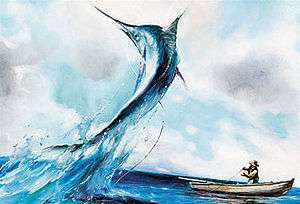
After the end of the Soviet Union, the situation for Russian animators changed dramatically. On one hand, State subsidies diminished significantly. On the other hand, the number of studios competing for that amount of money rose a good deal. Most of the studios during the 1990s lived on animation for advertisement and on doing commissioned works for big studios from America and elsewhere. Nevertheless, there were a few very successful international co-productions, e.g. Aleksandr Petrov's (former Sverdlovsk Film Studio animator) Oscar-winning The Old Man and the Sea (1999, from Ernest Hemingway's novel) or Stanislav Sokolov's The Winter's Tale (1999, from William Shakespeare's play) that earned the director an Emmy.
Despite the hardships, Natalya Lukinykh has estimated that Russian animated films won about twice as many prestigious international awards in the 1990s as Russian live-action films. As Russia's economic situation became increasingly stable, so did the market for animation, and during the last three years a number of feature-length animation films from Russian studios have emerged (e.g. Melnitsa Animation Studio's Little Longnose, 2003, from Wilhelm Hauff's fairy tale, and Solnechny Dom Studio's 2006 Prince Vladimir, based on early history of Rus' – the highest-grossing Russian animated film to date). While the Russian animation community is yet far from reaching the splendor it possessed before the end of the Soviet Union, a significant recovery is being made and it is becoming more and more clear that the revived Russian animation industry will be very different from what it was in the late 1980s. According to Andrei Dobrunov, head of Solnechny Dom, several Russian studios are currently working on some ten animated feature films.
Osobennyj , released July 31, 2006, was Russia's first CG-animated feature film. About 8 such films are now in production by various studios . At the same time, Soyuzmultfilm has partnered up with Mikhail Shemyakin and is working on Gofmaniada, a puppet-animated feature film which is deliberately being made entirely without computers. In 2007, the Morevna Project was launched, aiming at creating a science fiction re-telling the folk-tale of Marya Morevna as an anime primarily by using the free software Synfig tool and releasing it under a Creative Commons license.[4] Another popular Russian Internet cartoon is Masyanya. A corporate collaboration between the Japanese Studio 4°C and Russia's Molot Entertainment also produced the anime film First Squad: The Moment of Truth (2009), which won the Kommersant newspaper's prize.[5]
Beginning in 2009, animation entered a new crisis as Goskino indefinitely postponed funding for all projects, and for the 2010 budget the state cut animation funding by half. The animation community reacted by appealing to the President and the public. In 2010, many of the major studios, including Pilot, were either closed or on the verge of shutting down. The vast majority of studios had relied on state support to some extent, and Goskino did not fulfill any of their contractual obligations to pay for the films that they had ordered and which the studios had already produced. In addition, Disney has been accused of using anti-competitive practices to sideline domestic Russian competition on TV channels.
The Centre of National Film CG animated film Space Dogs, released on March 18, 2010 and about the Soviet space dogs Strelka and Belka, received an English release on June 8, 2012 and spawned a broader franchise. Wizart Animation, alongside InlayFilm, also produced a new CG film version of The Snow Queen (2012), spawning a new franchise with sequels Snow Queen 2: The Snow King (2014) and the upcoming The Snow Queen 3: Fire and Ice (2016), alongside their first fully original concept Sheep and Wolves (2015). Although these films have ultimately been successful in Russia, their quality of motion has been questioned in the West upon home release and limited theatrical run.[6]
Animaccord Animation Studio has had success in CG television animation with its children's series Masha and the Bear (2009–present), whose emphasis on pantomime has helped it export outside of the country, premièring on the US version of Netflix in August 2015.[7] Another long running, educational, children's series by Melnitsa Animation Studio called Luntik has aired since September 1, 2006. An earlier success in this market was Kikoriki which aired from May 7, 2004 until 2012, produced by Petersburg Animation Studio with assistance from the Ministry of Culture of the Russian Federation. English-language distribution rights to the series were acquired by 4Kids Entertainment from worldwide distributor Fun Game Media, Munich[8] and began airing as part of The CW4Kids block on The CW on September 13, 2008, under the name GoGoRiki.[9] In 2011 a prequel feature film was released entitled Kikoriki. Team Invincible and further films are planned. A connecting factor in many recent Russian animated efforts is Timur Bekmambetov, whose company Bazelevs has helped produce, finance and promote Kikoriki and The Snow Queen.[10]
In popular culture
- An episode of The Simpsons called "Krusty Gets Kancelled" features a parody of the Communist Bloc animation, a cat and mouse duo known as Worker and Parasite.
- In 2004 the Israeli couple Yonathan and Masha Zur, has released a documentary film about Russian Animation in Soviet Times, called Magia Russica.
Popular Animation Studios
- Soyuzmultfilm
- Melnitsa Animation Studio
- Petersburg Animation Studio
- Animaccord Animation Studio
- Wizart Animation
- InlayFilm
- Toondra
See also
- Nika Award
- Cinema of the world
- Encyclopedia of Domestic Animation
- KROK International Animated Films Festival
- Open Russian Festival of Animated Film
References
- ↑ Kisselgoff, Anna. Critic's Notebook; Pioneering Russian Films Show Ballet Master's Wit. New York Times. January 14, 2005. Accessed on: June 23, 2009.
- ↑ Lord, Peter. The start of stop-frame. The Guardian. November 14, 2008. Accessed on: June 23, 2009.
- ↑ SMARTNEWS Keeping you current Russia Has Its Own Classic Version of an Animated Winnie-the-Pooh
- ↑ The Morevna Project: Anime with Synfig and Blender
- ↑ "4°C's First Squad Wins Award at Moscow Int'l Fim Fest". Anime News Network. 2009-06-30. Retrieved 2009-10-11.
- ↑ ‘The Snow Queen’ review: Don’t drink that potion; you’ll fart incessantly (Video) in Examiner.com
- ↑ http://kidscreen.com/2015/06/03/netflix-picks-up-seven-new-kids-series/
- ↑ "GoGoRiki confirmed for fall 2008". Retrieved 2008-08-11.
- ↑ "4Kids announces fall 2008 Lineups for Fox and The CW". Archived from the original on January 4, 2009. Retrieved 2008-09-05.
- ↑ Check Out a Trailer for The Snow Queen, ComingSoon.Net (article by Silas Lesnick), October 28, 2012
- Bendazzi, Giannalberto. 1994. Cartoons. One Hundred Years of Cinema Animation. London/Bloomington: John Libbey/Indiana University Press.
- Giesen, Rolf. 2003. Lexikon des Trick- und Animationsfilms. Berlin: Schwarzkopf & Schwarzkopf.
- Leslie, Ester. 2002. Hollywood Flatlands. Animation, Critical Theory and the Avant-Garde. London, New York: Verso.
- Pilling, Jayne (Ed.). 1997. A Reader in Animation Studies. London et al.: John Libbey.
- Асенин, Сергей Владимирович. 1986. Мир мультфильма. Москва: Искусство.
- Венжер, Наталья Яковлевна (Ed.). 1990. Сотворение фильма. Несколько интервью по служебным вопросам. Москва: Союз Кинематографистов СССР.
- Иванов-Вано, Иван Петрович. 1978. Кадр за кадром, Москва: Искусство.
- Орлов, Алексей Михайлович. 1995. Аниматограф и его анима: психогенные аспекты экранных технологий. Москва: Импето.
External links
- Animator.ru – the homepage of the Russian animation community. Includes an English-language database of films, people and studios.
- Soyuzmultfilm homepage The most famous Russian animation studio's home page (Russian)
- www.pilot-film.com Another famous studio's homepage (in Russian and English).
- Russian Insider – a blog focusing on current and past Russian/Soviet animation
- www.filmfundsoyuzmultfilm.com Soyuzmultfilm's film archive.
- Soviet cartoons of the 1940s and the 1950s watchable and downloadable with Esperanto subtitles
- MASTERS OF RUSSIAN ANIMATION Video Collection on IFILM
- Blog about Russian Animation Influence in Cuban Culture
- Videoblog with modern Russian animation subtitled in Esperanto
- MAGIA RUSSICA – a documentary film on Russian Animation
News articles
- The St. Petersburg Times (Russia) – a May 2006 article about the film Prince Vladimir and the future of the animation industry in Russia
- Redrawing Russian History (May 18, 2006)
- In-depth history of the appalling and criminal happenings at Soyuzmultfilm during the 1990s (Russian)
- An overview of Russian animated feature films in the 1990s and early 2000s (Russian)
- Russian animation in search of a hero Maria Tereschenko, Russia Beyond the Headlines, December 17, 2009 (English), article with some animated films with English subtitles.
| ||||||||||||||||||||||
| ||||||||||||||||||||||||||||||||||||||||||||||||||||||||